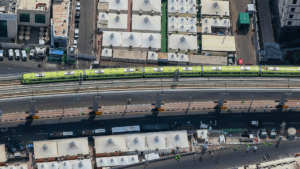Weather in Makkah
As millions of devout Muslims from around the world prepare for the spiritual journey of a lifetime to perform the annual Hajj pilgrimage, understanding the weather in Makkah (Mecca) becomes an essential aspect of planning and preparation. However, this guide is not only beneficial for Hajj pilgrims but also serves as a valuable resource for anyone planning a visit to this sacred city at any time of the year.
Seasons and Temperatures in Makkah
Makkah, a city located in the western part of Saudi Arabia, is known for its hot desert climate. This means high temperatures, low humidity, and minimal rainfall. Yet, there are specific nuances of the Makkah climate that are important to understand to be better prepared and make your stay comfortable and fulfilling.
Summer (April – October)
Summers in Makkah are intense and lengthy, often extending from April to October. During the Hajj, which takes place in June last week this year, temperatures can range between 30°C (86°F) and 45°C (113°F), occasionally soaring higher.
Dehydration and heat exhaustion are common risks during this time, especially when engaging in outdoor activities. Thus, ensuring you’re well hydrated and wearing suitable, breathable clothing are key aspects to keep in mind.
Winter (November – March)
Winter months, from November to March, are milder and more comfortable. Daytime temperatures typically range from 18°C (64°F) to 30°C (86°F), while nighttime can bring cooler temperatures, dropping to around 16°C (61°F) in the coldest months.
Although winters in Makkah are not characterized by extreme cold, carrying light sweaters or jackets for the cooler evenings can make your stay more comfortable.
Precipitation and Humidity
Despite its desert climate, Makkah does experience occasional rainfall, primarily between November and January. While rain is generally light and sporadic, heavy downpours can sometimes occur, leading to flash flooding in certain areas. Therefore, it is advisable to stay updated with the local weather forecasts during this period.
The humidity in Makkah fluctuates, with the highest levels usually occurring during summer. Evenings can become quite humid, making the heat feel more intense.
Preparation and Advice for Pilgrims and Visitors
Understanding the weather patterns in Makkah is crucial to prepare effectively for your journey, whether for Hajj or any other time of the year. Here are some useful tips:
- Stay Hydrated: Drink plenty of water to counter dehydration, especially during the hot summer months. Avoid caffeinated drinks as they can lead to further dehydration.
- Dress Appropriately: Dressing in loose, light-colored, and breathable clothing can help keep your body cool. Remember to respect the local customs and traditions related to attire.
- Sun Protection: Use a high-factor sunscreen to protect your skin from the intense sun rays. A hat or umbrella can also provide additional protection during peak sunlight hours.
- Monitor Weather Forecasts: Stay updated with the latest weather forecasts and plan your outdoor activities accordingly.
Conclusion
Makkah’s weather, while primarily hot and dry, can vary throughout the year, making it essential for visitors and pilgrims to plan accordingly. By understanding these patterns and preparing effectively, your journey to this spiritually significant city can be made more comfortable and rewarding. After all, a successful pilgrimage or visit is not just about reaching the destination, but also about the journey and the experiences along the way.
More Articles from KSAexpats.com:















